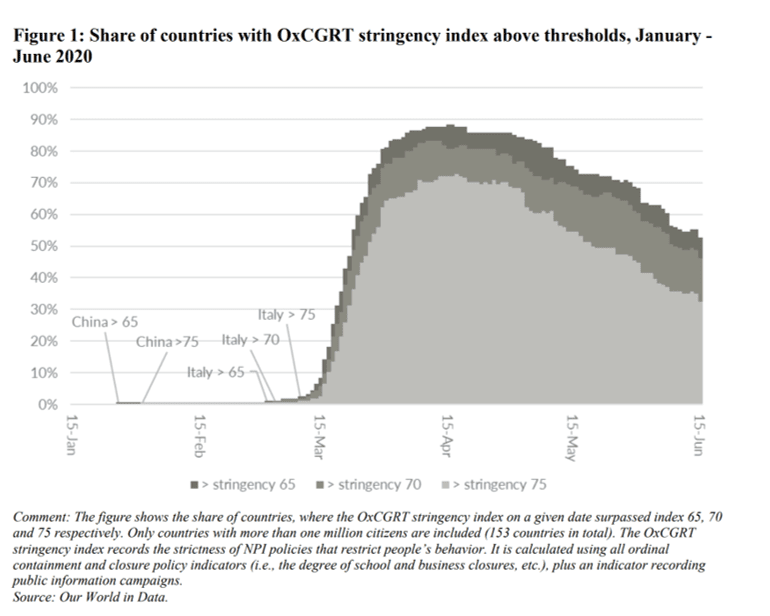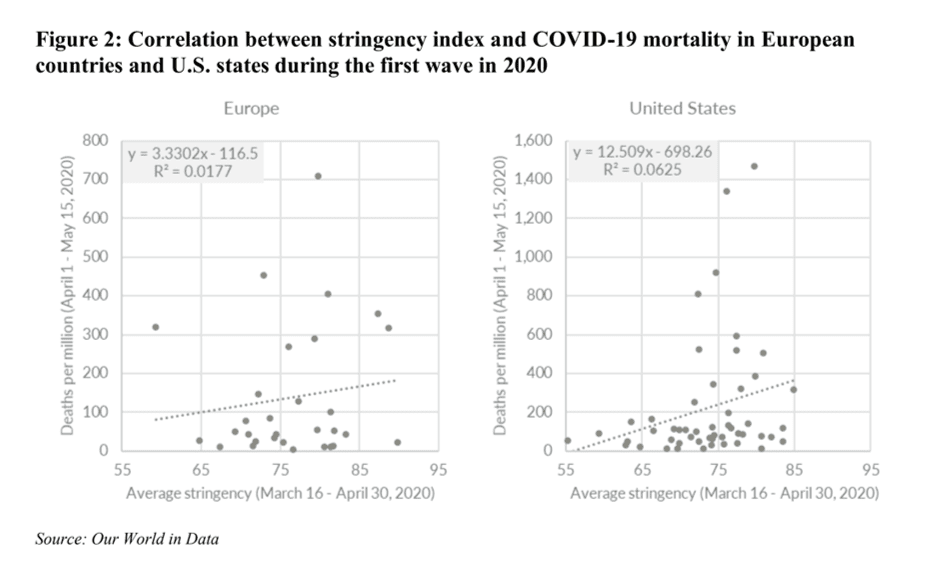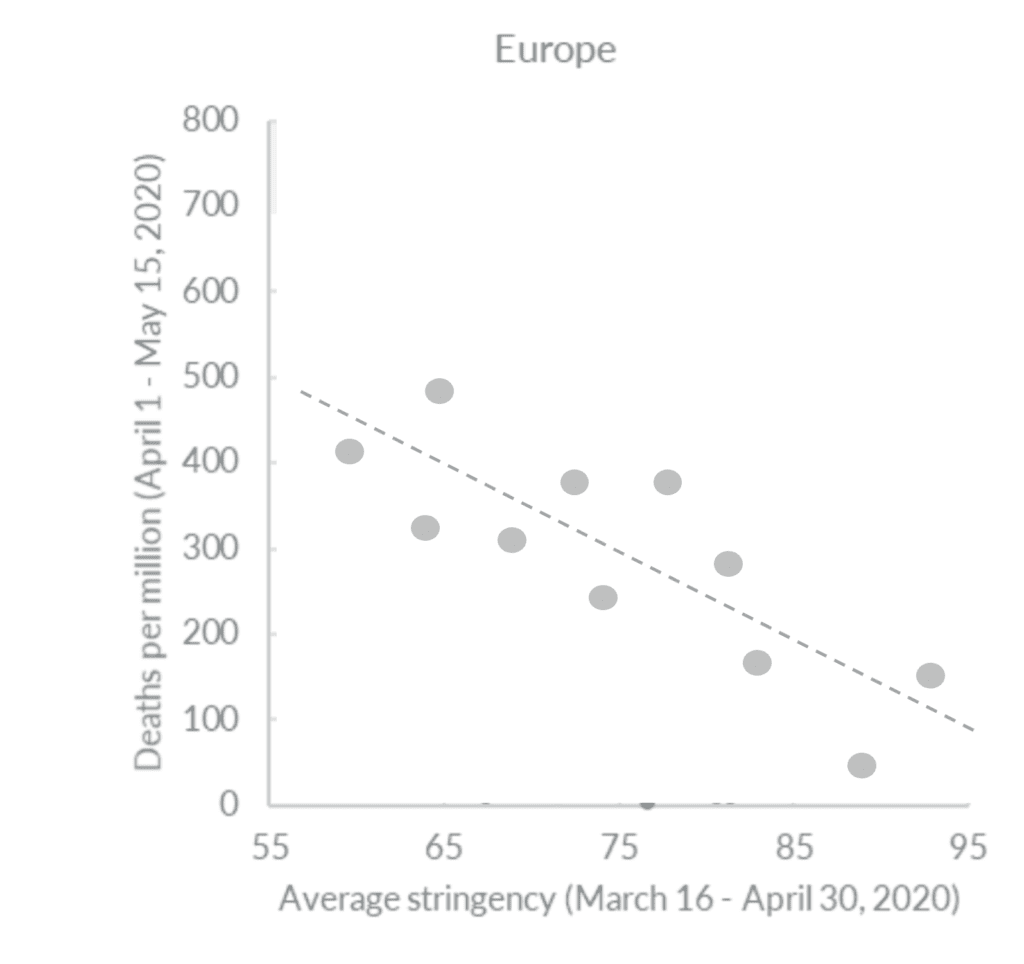Did Lockdowns Work? Graphs that Will Astound You

Credit: Shutterstock
Science as a discipline only works when we can learn from our mistakes and correct them. Hence, you can expect that now that the dust is beginning to clear from the Omicron wave of COVID that researchers will be reexamining all of our pandemic data and assumptions. As I have reported before, you can expect many things you thought you knew about the pandemic will change. Today we’ll review a really big study by Johns Hopkins that asked the critical question, “Did lockdowns work?”. Let’s dig in.
Early 2020
If you remember the early days of the pandemic, way back when in March of 2020, the idea of locking down society and closing almost all businesses while we sheltered in place at home was first introduced. The news coverage at that time was very clear. The purpose of this order was not to reduce deaths overall, but simply to reduce the strain on the hospital system. In the end, the total number of deaths would simply be pushed down the road. All of that made sense, so we all complied and hospitalizations decreased.
That US strategy from our first COVID wave is what I call, “Protect the Hospital System” and it made good public health sense. However, somewhere in there, many societies around the world morphed that strategy into another one called “Zero COVID”. In this new strategy, society would intermittently lockdown and even when open, would remain a shadow of its former self while exposures between people were minimized. The idea was that this would save lives. So did that “Zero COVID” lockdown strategy actually work?
The New Johns Hopkins Study
The Johns Hopkins School of Applied Economics just published a paper entitled, “A Literature Review and Meta-Analysis of the Effects of Lockdowns on COVID-19 Mortality”. Two of the authors are from Europe (Lund University in Sweden and the University of Copenhagen in Denmark) and one from Johns Hopkins. That’s critical as much of Europe pursued the “Zero COVID” strategy while Sweden did not.
They begin this paper by introducing a “Stringency Index” which is how much each country restricted their citizens:

This graph shows the percentage of countries that had various stringency indexes over time through the COVID first wave. That scale is 0-100 with 100 being the strictest lockdown.
The authors then discuss that the Imperial College of London model had predicted during the first wave, that a strict lockdown strategy would reduce COVID mortality by as much as 98%! Remember that claim as we go through this data, as many countries then acted like they believed that this 98% number was accurate.
Our friends at Johns Hopkins don’t waste any time in telling us what actually happened as they show this “money shot” graph right away:

This graph is a VERY BIG problem for countries that took the advice of The Imperial Collge of London. Why? Well, first let me show you what this graph should look like if lockdowns were very effective at reducing deaths due to COVID-19:

To understand what a “$h#t show” the real lockdown graphs are, let’s dive into the one I created above. In my theoretical graph, the more stringent the country’s lockdown (higher stringency index from 0-100), the lower the COVID-19 death rate per million. Hence, our dashed line shows a trend that goes down from left to right.
Now, look at the real Johns Hopkins graphs above. Those trend lines go upward. In addition, the data points don’t cluster closely around that line, showing that if anything the correlation is poor. Hence, those graphs tell us that if anything, COVID-19 deaths went UP as the stringency of the lockdowns INCREASED. YIKES! That means that public health officials running entire countries and recommending lockdowns did the opposite of what should have been done. It also shows us that the predictions by the vaunted Imperial Collge of London model weren’t worth the proverbial paper they were written on.
The conclusion of this paper was: “More specifically, stringency index studies find that lockdowns in Europe and the United States only reduced COVID-19 mortality by 0.2% on average.” Double Yikes!
Lockdowns and Unintended Consequences
So while we now know that lockdowns had little impact on COVID mortality, we do know that they did likely cause mortality due to unintended consequences. That would be a rise in deaths due to the delayed diagnosis of curable disease, suicides, and drug overdoses.
We are just now beginning to scientifically quantify the negative effects of shutdowns and other mitigation measures on society. For example, we know that cancer screenings and diagnoses plummeted (2,3). This will lead to many more otherwise preventable cancer deaths. There were also quantifiable impacts on mental health with large spikes in depression, substance abuse, and anxiety (4). For example, suicide rates among African American residents in one state exploded 94% (5). In addition, drug overdoses resulting in death were up as much as 60% in the US and Canada (6).
Perfect Data?
Much of medicine and the decisions we make are based on “best available evidence”. For example, you could argue that the study above suffers from the fact that the healthcare systems in these counties are different. After all, first-world countries have better healthcare systems than those in the third world. However, adjusting for those kinds of variables is always a “best educated guess”, so regrettably, this is about as good as this data will get. Meaning it’s “best available evidence”.
Everything You Thought You Knew About COVID is About to Change
I’ve already blogged on the fact that entire states are beginning to adjust their COVID death totals downward by as much as 50%. That comes from the fact that widespread hospital testing of all admitted patients identified many positive asymptomatic patients admitted for other things and those deaths were erroneously added to the COVID death stats. Hence, our hospitalization and death totals will likely be adjusted WAY down. These changes will happen because there has now been enough time for qualified scientists to begin to review the data, analyze it, and get something published.
The upshot? Based on this data analysis, lockdowns don’t work. Just how badly they failed is hard to visualize if you don’t look at scientific data and correlation graphs for a living, but suffice it to say that anyone who does who looks at those graphs above will gasp. That’s the magnitude of just how wrong public health officials were on this one. The moral of that story is NEVER let politicians and the media be in charge of public health decisions. Those decisions should only be the purview of the medical profession.
___________________________________
References:
(1) Herby J, Jonung L, Hanke S. A LITERATURE REVIEW AND META-ANALYSIS OF THE EFFECTS OF LOCKDOWNS ON COVID-19 MORTALITY. https://sites.krieger.jhu.edu/iae/files/2022/01/A-Literature-Review-and-Meta-Analysis-of-the-Effects-of-Lockdowns-on-COVID-19-Mortality.pdf
(2) Asai Y, et al. Impact of the COVID-19 pandemic on skin cancer diagnosis: A population-based study. Published: March 31, 2021
https://doi.org/10.1371/journal.pone.0248492
(3) Gurney JK, Millar E, Dunn A, Pirie R, Mako M, Manderson J, Hardie C, Jackson CGCA, North R, Ruka M, Scott N, Sarfati D. The impact of the COVID-19 pandemic on cancer diagnosis and service access in New Zealand-a country pursuing COVID-19 elimination. Lancet Reg Health West Pac. 2021 May;10:100127. doi: 10.1016/j.lanwpc.2021.100127. Epub 2021 Mar 22. PMID: 33778794; PMCID: PMC7983868.
(4) KFF. The Implications of COVID-19 for Mental Health and Substance Use https://www.kff.org/coronavirus-covid-19/issue-brief/the-implications-of-covid-19-for-mental-health-and-substance-use/
(5) Hopkins Medicine. Suicides Rise in Black Population During COVID-19 Pandemic. https://www.hopkinsmedicine.org/news/articles/suicides-rise-in-black-population-during-covid-19-pandemic
(6) Imtiaz, S., Nafeh, F., Russell, C. et al. The impact of the novel coronavirus disease (COVID-19) pandemic on drug overdose-related deaths in the United States and Canada: a systematic review of observational studies and analysis of public health surveillance data. Subst Abuse Treat Prev Policy 16, 87 (2021). https://doi.org/10.1186/s13011-021-00423-5

If you have questions or comments about this blog post, please email us at [email protected]
NOTE: This blog post provides general information to help the reader better understand regenerative medicine, musculoskeletal health, and related subjects. All content provided in this blog, website, or any linked materials, including text, graphics, images, patient profiles, outcomes, and information, are not intended and should not be considered or used as a substitute for medical advice, diagnosis, or treatment. Please always consult with a professional and certified healthcare provider to discuss if a treatment is right for you.